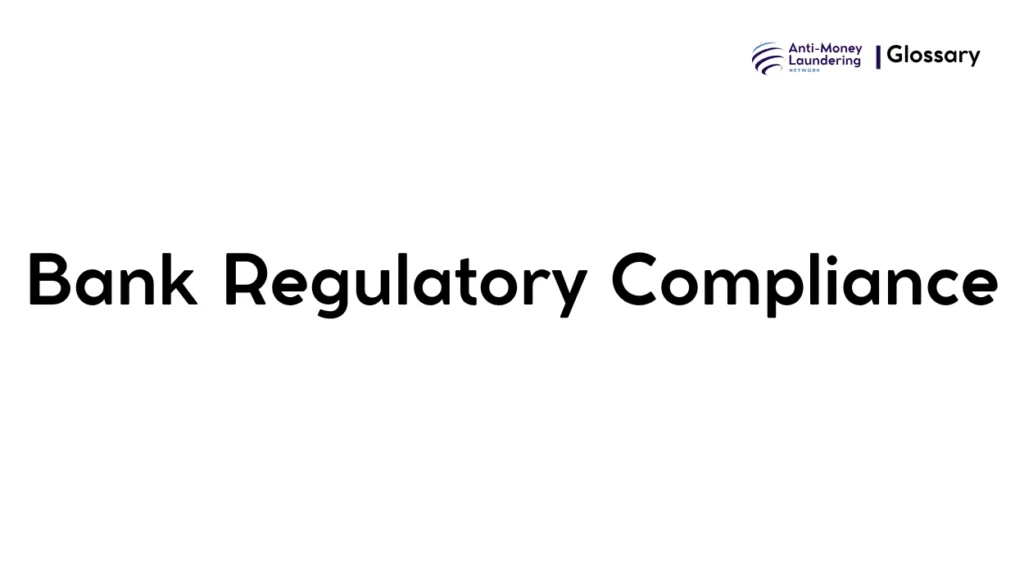Definition
Bank Regulatory Compliance in Anti-Money Laundering (AML) refers to the systematic adherence by banks and financial institutions to laws, regulations, and guidelines aimed at preventing money laundering, terrorist financing, and related financial crimes. It encompasses the policies, procedures, controls, and reporting mechanisms put in place to meet AML regulatory requirements imposed by governmental authorities and international bodies.
Purpose and Regulatory Basis
Role in AML
The primary purpose of bank regulatory compliance in AML is to detect, prevent, and report suspicious monetary activities that may be connected to criminal enterprises, terrorism financing, or illicit proceeds. Compliance ensures banks act as gatekeepers in the financial system, safeguarding its integrity and reducing risks of financial crime.
Why it Matters
Non-compliance can lead to severe penalties, legal actions, loss of reputation, and systemic risks. Further, effective compliance promotes transparency, stability, and trust in the global financial system.
Key Global and National Regulations
- Financial Action Task Force (FATF): Sets global AML standards and issues recommendations for countries to implement.
- USA PATRIOT Act: U.S. law strengthening AML requirements, such as Customer Identification Programs (CIP).
- European Union Anti-Money Laundering Directives (AMLD): EU laws establishing AML obligations across member states.
- Other notable frameworks: Bank Secrecy Act (BSA) in the U.S., Proceeds of Crime Act (PoCA) in the UK, and local AML laws per jurisdiction.
When and How It Applies
Real-World Use Cases
- Customer onboarding: Verifying identity and assessing AML risk before account opening.
- Transaction monitoring: Continuous automated and manual review of transactional data for suspicious patterns.
- Enhanced due diligence (EDD): Applied when higher risk of money laundering is identified (e.g., Politically Exposed Persons, high-value transactions).
- Reporting: Filing Suspicious Activity Reports (SARs) or suspicious transaction reports when red flags arise.
Triggers and Examples
- Frequent large cash deposits inconsistent with the customer’s profile.
- Unexplained international wire transfers involving high-risk jurisdictions.
- Use of complex corporate structures to obscure ownership.
Types or Variants
While bank regulatory compliance under AML generally follows a unified framework, variants exist according to:
- Jurisdictional Scope: Domestic compliance vs. cross-border compliance considerations.
- Customer Type: Retail clients vs. corporate clients requiring different levels of scrutiny.
- Transaction Types: Cash transactions, electronic funds transfers, correspondent banking, trade finance, etc.
- Industry-specific Requirements: Banks versus non-bank financial institutions (NBFIs), such as insurance or brokerage firms.
Each variant adapts the core compliance framework to specific operational and regulatory contexts.
Procedures and Implementation
Steps for Compliance
- Risk Assessment: Identify and classify risks related to geography, customer types, products, and transactions.
- Policies and Controls: Develop AML policies guided by risk appetite and regulatory requirements.
- Customer Due Diligence (CDD): Verify identity, perform KYC (Know Your Customer) procedures, and categorize risks.
- Ongoing Monitoring: Use automated systems and manual reviews to monitor transactions for suspicious activities.
- Employee Training: Regular AML training programs for staff to ensure awareness and competence.
- Record Keeping: Maintain evidence of due diligence, transaction data, and communications as per legal retention periods.
- Reporting: Timely submission of SARs and regulatory reports to specified authorities.
- Independent Audits and Reviews: Regular internal and external audits to verify compliance effectiveness.
Systems, Controls, and Processes
- Automated Transaction Monitoring Software: Detect unusual patterns.
- Know Your Customer (KYC) Platforms: Streamline customer identification.
- Sanctions Screening Tools: Ensure no dealings with prohibited parties.
- Case Management Systems: Document investigation and remediation efforts.
Impact on Customers/Clients
Rights
Customers have the right to privacy, fair treatment, and access to grievance redressal under AML regimes. Banks must balance compliance while respecting these rights.
Restrictions
AML compliance may result in certain restrictions for customers, such as enhanced verification, reporting of certain transactions, or account freezes if suspicion arises.
Interactions
Customers may experience additional documentation requests, interviews, or delays caused by compliance checks, especially in high-risk scenarios.
Duration, Review, and Resolution
- Duration: AML compliance activities are continuous throughout the relationship with the client.
- Review: Periodic reviews of customer profiles and transaction activities to ensure risk assessment remains current.
- Resolution: When suspicious activity is identified, investigations are conducted, and necessary actions like filing SARs or terminating relationships may follow.
Reporting and Compliance Duties
- Institutional Responsibilities: Maintain a designated AML compliance officer, implement AML programs, and keep comprehensive records.
- Documentation: Sustain detailed records of CDD, monitoring, investigations, and communications.
- Penalties: Institutions face fines, sanctions, reputational damage, or license revocation for non-compliance. Senior management may also face personal penalties.
Related AML Terms
- KYC (Know Your Customer): Related process for verifying the identity of customers.
- CDD (Customer Due Diligence): Assessing risk levels of clients.
- EDD (Enhanced Due Diligence): In-depth scrutiny for higher risk clients.
- SAR (Suspicious Activity Report): Reporting mechanism for suspicious transactions.
- Sanctions Compliance: Ensuring transactions comply with sanctions lists, closely linked with AML compliance.
Challenges and Best Practices
Challenges
- Balancing customer experience and regulatory requirements.
- Keeping pace with evolving regulations and technologies globally.
- Managing false positives from automated monitoring systems.
- Ensuring uniform compliance across branches and subsidiaries in diverse jurisdictions.
Best Practices
- Implement risk-based approach tailored to the institution’s profile.
- Use advanced AI and machine learning to reduce false positives.
- Regular updates and training for staff on emerging risks and rules.
- Strong governance with clear compliance responsibilities and escalation paths.
Recent Developments
- Technological Advancements: Adoption of AI, blockchain analytics, and biometrics for more effective AML compliance.
- Regulatory Evolution: New regulations requiring beneficial ownership transparency and stricter controls on cryptocurrencies.
- International Cooperation: Enhanced cross-border efforts to share information and enforce AML measures globally.
- Focus on Environmental Crime and Fraud: Extending AML compliance beyond traditional financial crimes towards new risk areas.
Bank Regulatory Compliance in Anti-Money Laundering is a cornerstone for safeguarding the financial system from illicit activities. It requires institutions to implement robust policies, procedures, and technologies aligned with global and national regulations. Successfully achieving compliance protects banks, customers, and the broader economy by promoting transparency and mitigating financial crime risks.

